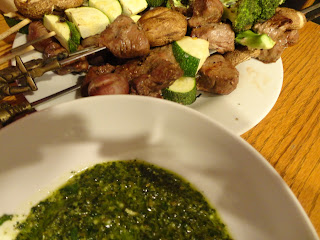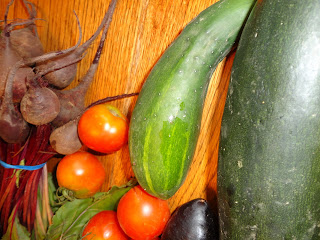My CSA box this week contained:
Lettuce, basil, snap peas, squash, zucchini, kale, cucumbers, radishes, broccoli, spinach, bok choy, and eggs.
So many leafy greens!

Here is a riddle that I have heard:
Q: What is the only fruit or vegetable that is not frozen, dried, pickled, or preserved in any way?
A: Lettuce
This riddle is false per my kitchen this year.
I know last year I was trying to figure out what to do with additional lettuce.
I wilted some of it like a bitter green. It was pretty bad.
But lettuce is one of those things that just keeps coming. And it starts far before the rest of your salad ingredients are ready to pick. And if you don't keep up with it, it turns bitter and gross. I know that my CSA box has recently been packed with it in all it's forms, coming faster than I can use it. And that doesn't include the lettuce that's quickly turning bitter in my garden. Lettuce, beet greens, Swiss chard, bok choy, spinach, arugula, not to mention the mint and oregano that is quickly taking over by back yard...
So what do you do with it all? I hate waste.
I have tried blanching and freezing spinach. It's an option, but frankly I don't feel like it thaws out well enough that I ever really want to eat it. It's good for stuff that frozen spinach goes in to, like a spinach dip (and who doesn't love
a good spinach dip), but that's really about it. It's certainly not something that I would just eat as a side dish for dinner - especially when some of the vendors at the winter farmer's market have spinach growing in their greenhouses almost all year long.
I was watching the Cooking Channel, and Alton Brown was making
Pistachio and Mixed Herb Pesto. This got me thinking about spinach pesto, and arugula pesto, both of which I have eaten and which taste good. Which was a light bulb moment for me: you can make pesto out of any leafy green.
Even lettuce.
(I talked about and provided my lettuce pesto recipe
here.)
And once pesto is made, it is easily frozen and lasts up to a year. Meaning lettuce can be frozen and saved for later!
My basic pesto recipe is:
- 2 tbsp toasted nuts
- 2 tbsp garlic
- 2 cups green stuff
- 1/4 cup olive oil
- 2 tbsp shredded cheese
Process nuts, garlic, and greens in a food processor until combined into a thick paste, but not past the point where you can still see flecks of individual ingredients. Slowly add the olive oil while continuing to process. Add the cheese when ready to serve.
 |
| It should look kind of like this |
The good thing about this recipe is that two cups of any leafy green is not really a lot. This is basically the tops of any bunch of veggies you might pick up. No, those tops are not garbage! If you're paying by the pound, you paid for those tops! So you might as well get as much as you can out of them. If they're fresh and you're in the mood, saute them up and serve them for dinner. But, if you don't have time, why not take 5 minutes (that's really all this recipe takes) and turn them into some pesto that you can use later.
Here are a few examples:
I thinned my carrots and turned the carrot greens into pesto. I used walnuts instead of pine nuts because walnuts go into carrot cake. I wish that I had planted more carrots so I had more greens to thin. If you've never had carrot greens, they're definitely lightly carrot flavored, but also have a serious grass/clover flavor to them. Like good grass. Like when you're a kid and you chew on a long stalk of grass. Combined with the walnuts which are a little sweet, I felt this was done without the cheese. I also did not add any garlic (I know, shocking, right?!?) I got only one serving, which I have not made into a meal yet, but I am waiting to pair it with something with a strong flavor like beef. I'm thinking this would be a great topping to a steak sandwich. Last summer (after scouring the internet and deciding they were not poisonous), I put my carrot tops into my
chicken stock. In retrospect, I think that was a waste. This is how I'm using my carrot tops from now on.
Next came beet greens. I again used the walnuts, because I bought too many for the carrots and I didn't want to hang on to them. I also found a fair number of beet and walnut salad recipes on the internet, so I figured they had to be a good pairing. When I tasted it, I wanted it to be just a little sweeter. The beets are sweet, but I didn't think this carried through in the beet green pesto. It was confusing. Are you sweet? Are you not sweet? Pick one and go with it! So I ran to the store and picked up some maple candied macadamia nuts. Pricy? Yes. Amazing? Also yes. These are sold in bulk at my local natural foods store and they are absolutely my favorite snack that I cannot afford. So I used you good readers as my excuse to purchase far more than I needed which I will be taking to work to eat there. Taste wise, the first was fair, the second amazing. Appearance wise, both were a little lacking. Beets bleed. They make a mess of my hands and cutting board and counter every time I cook them. The greens, while mostly green, contain some of the color and all of the bleeding in their stems. When this was split in the food processor, the red color went everywhere, combined with the green leaves, and mostly looked brown. Still delicious, but I wouldn't recommend this for your fancy food party.
Then arugula with pine nuts, and spinach with almonds. Spinach/almond is my favorite, because it just feels so healthy!
Last but not least, mint pesto. I used the traditional pine nuts, but any of the other options would work too. This is some serious stuff, and I wouldn't recommend using it straight up in a pasta. A better choice again would be a spread on a sandwich, or maybe an accompaniment to some fish or lamb.
For a quick dinner, I made some beef, zucchini, mushroom, and potato shish kabobs. I boiled the potatoes first so they were almost completely cooked, seasoned everything with salt and pepper, then threw the skewers on the grill for about 3 minutes per side. I was lucky enough to receive some tenderloin tips for kabobs along with my beef purchase, but you could really make these with any kind of beef. Or lamb. Or chicken. Or shrimp...
 |
| The finished product. You can still see the individual little bits |
Mint Pesto DipMakes enough to freeze for later
- 2 tablespoons pine nuts
- 2-3 large garlic cloves, roughly chopped
- 2 cups mint leaves, washed
- 1/4 cup olive oil
Heat a large, heavy skillet over medium high heat (no oil). Add pine nuts, and toast,stirring frequently, until pine nuts start to smell extra nutty and get just a little brown. Be careful, when they go they go fast. If you burn them, throw them away and start over!
Remove the toasted pine nuts from the pan immediately (if you leave them in there, they will keep cooking!), and add to the bowl of a food processor. Add garlic cloves, and process for 4 to 5 short pulses, until the nuts and garlic are just broken up.
Add the mint, and continue to process, until you have a mixture that resembles a flecked counter top - it's consistent in it's appearance, but you can still see the individual pieces that make up the pesto. Add the olive oil and process for two or three more short pulses to combine.
Dip your kabob meat and vegetables into the pesto. It is also excellent as a spread on some good crusty bread.
 Lettuce Pesto
Lettuce Pesto
(Reprinting, just to have them all together)
- 2 tbsp pine nuts
- 2 tbsp garlic scapes,
- 2 large hand-fulls of lettuce, washed and dried
- 1 tbsp finely grated Parmesan cheese
- 1/4 to 1/2 cup olive oil
Toast the pine nuts as above.
Meanwhile, coarsely chop the garlic scapes. Add the garlic to the pine nuts in the food processor,
and process as above
Add the lettuce (I needed to add lettuce in two batches, because it
didn't fit in my food processor bowl. This is perfectly fine.) and
process until the lettuce is just broken down into small pieces. should
still be able to see individual bis of lettuce, nut, and garlic.
Continue to process, adding olive oil in a slow stream. How much you
use will depend on what you are using your pesto for - a spread will get
less oil, while a pasta sauce will need more.
I recommend serving this on a cold pasta salad, because when warm it tastes a little like warm lettuce, which is weird.
Beet Green Pesto
(The ratios are changed up a little here to emphasize the sweet flavor of the beets)
- 2-3 tbsp maple macadamia nuts
- 1 tbsp garlic scapes
- 1/4 cup sweet Italian basil
- 2 cups beet greens, stems removed
- 1/2 cup olive oil
Combine nuts and garlic in a food processor, and process as above (no toasting this time).
Add basil and beet greens, and process as above.
Slowly add in olive oil, and continue to process until combined.
While not particularly pretty, this was a delicious, light, and sweet pesto. I would recommend it with pasta and seafood. I'm thinking along the lines of some angel hair pasta mixed with the pesto, topped with grilled beet slices and maple bacon wrapped scallops.
That will have to be dinner very soon!




































